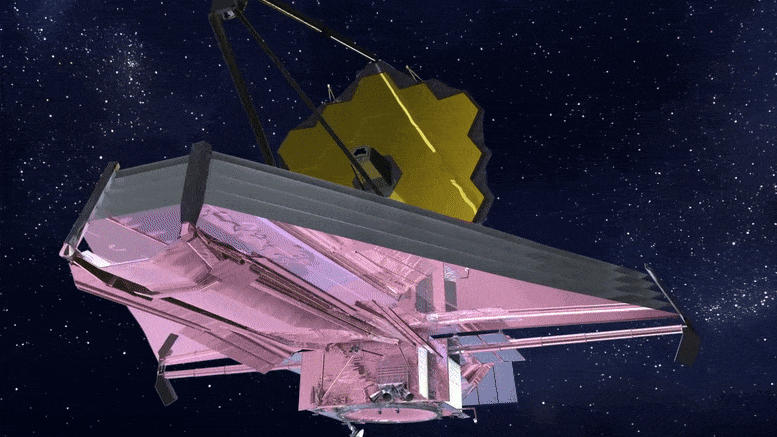A major milestone for the James Webb Space Telescope, what astronomers could learn from a “mini” monster black hole, and the latest assessment of our planet’s global surface temperature … a few of the stories to tell you about – This Week at NASA!
Video transcript:
A major milestone for the James Webb Space Telescope, what astronomers could learn from a mini monster black hole, and the latest assessment of our planet’s global surface temperature – a few of the stories to tell you about this week at NASA.
And we have a fully deployed JWST observatory.
[Music]
On January 8th, our James Webb Space Telescope team reached a major mission milestone when it finished deploying the telescope’s 21-foot primary mirror. That successfully completed the final stage of all major spacecraft deployments needed to prepare for science operations.
The next step is to begin moving the 18 primary mirror segments to align the telescope optics – a process that will take months to complete. For more details about the mission visit nasa.gov/webb.
Our Chandra X-ray Observatory has identified a supermassive or monster black hole in the dwarf galaxy MRK 462 that could help astronomers learn more about how the very largest black holes grow.
This is one of the first times that an obscured supermassive black hole has been found in a dwarf galaxy. MRK 462 contains only several hundred million stars by contrast there are a few hundred billion stars in our Milky Way galaxy.
According to independent analyses done by NASA and the National Oceanic and Atmospheric Administration, our planet’s global average surface temperature in 2021 tied with 2018 as the sixth warmest on record. This continues a long-term global warming trend during which the past eight years have been the warmest years on record.
Tracking global temperature trends provides a crucial indicator of the impact human activities are having on the climate and quality of life on Earth. Learn more about NASA’s Earth science missions at nasa.gov/earth.
On January 10th, NASA administrator Bill Nelson announced that Dr. Katherine Calvin will serve as the agency’s new chief scientist and senior climate advisor. She replaces former chief scientist Jim Green who recently retired and Gavin Schmidt who was serving as the acting senior climate advisor.
The senior climate advisor position was established to ensure effective fulfillment of the Biden Harris administration’s climate science objectives for the agency.
Also on January 10th, our 10 newest astronaut candidates reported for duty at our Johnson Space Center and were sworn in kicking off their two-year training schedule.
When their training is complete they could be assigned to missions aboard the International Space Station, launches from American soil on spacecraft built by commercial companies, or Artemis missions to the moon with NASA’s Orion spacecraft and Space Launch System rocket.
As teams continue to prepare our Space Launch System or SLS rocket for this year’s uncrewed artemis one flight test around the moon we and our partners across the country are also making progress building the rocket for Artemis II the first Artemis moon mission with astronauts.
We are also busy manufacturing and testing major parts of rocket hardware for the Artemis 3, 4, and 5 missions. With Artemis, we will land the first woman and the first person of color on the moon and establish long-term lunar exploration in preparation for human missions to Mars.
That’s what’s up this week at NASA for more on these and other stories follow us on the web at nasa.gov/twan.
https://news.google.com/__i/rss/rd/articles/CBMibmh0dHBzOi8vc2NpdGVjaGRhaWx5LmNvbS9hLW1ham9yLW1pbGVzdG9uZS1mb3ItdGhlLWphbWVzLXdlYmItc3BhY2UtdGVsZXNjb3BlLWEtbWluaS1tb25zdGVyLWJsYWNrLWhvbGUtdmlkZW8v0gFyaHR0cHM6Ly9zY2l0ZWNoZGFpbHkuY29tL2EtbWFqb3ItbWlsZXN0b25lLWZvci10aGUtamFtZXMtd2ViYi1zcGFjZS10ZWxlc2NvcGUtYS1taW5pLW1vbnN0ZXItYmxhY2staG9sZS12aWRlby9hbXAv?oc=5
2022-01-15 12:37:43Z
1205415723

Tidak ada komentar:
Posting Komentar